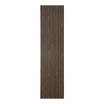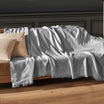Cleaning a Sofa - Simple Tips for a Clean Couch
When it comes to stains on the sofa, speed is of the essence. The faster you act, the easier it is to prevent stubborn stains. An upholstery cleaner and a soft cloth will assist you in efficient cleaning in the living room. Below, we provide you with an overview.
Step-by-Step Guide: Spilled Drinks on the Couch
If a glass of juice, cola, or wine has spilled on the sofa or armchair, time is working against you. The same applies if a cat or dog has urinated or more. Proceed as follows for stain removal:
Initial surface cleaning
First, get some paper towels or an old towel to immediately remove any moisture that is still on the surface. Gently dab the liquids for basic cleaning. However, do not rub the fabric during sofa cleaning. Careful brushing might be an option.
Cleaning a leather couch
With a leather or faux leather sofa set, you have a bit more time, as the materials in most cases repel moisture. Many fabrics are only partially water-resistant, allowing liquids to quickly penetrate and dry in the fibers.
For a leather or faux leather couch, simply wiping it down with a damp cloth afterwards is sufficient to make everything look fresh again. This prevents larger stains.
Procedure for a fabric couch such as microfiber
For a fabric sofa, you should sprinkle salt on the affected area afterwards. Make sure to distribute the salt to the edges as well. The salt helps to draw moisture out of the textiles. After about 15 minutes, you can remove the salt with a vacuum cleaner.
There are also special carpet cleaners for use on sofa covers or for suede. Once the initial emergency measures are dealt with, you have a bit more time and peace. In the next step, you can spray on a fabric cleaner or stain remover. Spray the cleaner on the stain, spread it with a lint-free cloth, and let it work according to the care instructions.
Typically, the time frame is between 10 to 15 minutes. Afterwards, you wipe off the remnants of the cleaning agent with a damp or dry cotton cloth. For stubborn stains, it may be necessary to repeat the procedure. There might also be removable parts that can be washed in the washing machine.
Tip: For food leftovers, vomit, or pet feces in the household, proceed in a similar manner. However, be careful! Solid chunks must first be removed from the affected areas using gentle methods. Make sure not to rub too much initially to prevent the substances from penetrating the fibers of the couch.
Removing stubborn stains: Here's how!
To remove stubborn dirt, you can either use special textile cleaning agents such as powder or resort to a steam cleaner.
Upholstery cleaner as a solution for stains on the sofa
Special stain removers consist of various chemical and biological substances. Depending on which textile cleaner you use, it can be aggressive and may damage the upholstery. This is mostly evident through fading of the cleaned area.
To prevent this issue, you should test the sofa cleaner on an inconspicuous area of the sofa fabric first. The procedure with the stain remover itself is simple:
- Spray the cleaner directly onto the stain. Make sure to include the edges.
- Allow the stain remover to work according to the instructions.
- Subsequently, a dry or wet wipe is performed using a lint-free cloth.
Upholstery cleaners are suitable for various types of stains. Thus, you can remove blood, mud, or ash from the upholstery and clean it easily. However, most cleaners are versatile.
Treating upholstered furniture with a steam cleaner
Unlike upholstery cleaners and home remedies, a steam cleaner is suitable for deep cleaning. Only use devices that are capable of immediately removing the applied moisture and the corresponding cleaners.
In the cleaning method, a cleaning solution is applied under pressure. An integrated suction function of the nozzle ensures that dirt and residues of cleaning agents are removed directly. A positive effect is that this also allows you to remove mites and pet hair particularly effectively with the wet vacuum cleaner.
The problem is that this type of steam upholstery cleaning is particularly aggressive. Delicate fabrics can be damaged by the liquid and the temperature of the wet vacuum cleaner. Here too, it is advisable to test the cleaning on an inconspicuous area.
In terms of effectiveness, there is no better method to restore the hygiene of the first day.
Tip: If it is a high-quality sofa set, it may be wise to consider professional sofa cleaning. The costs are significantly higher. However, you benefit from the expertise and the safety of the chosen cleaning method.
Tips for Cleaning Sofas of Different Materials
Depending on whether you own a microfiber, smooth leather, or woven fabric couch, the care required varies significantly. However, it is generally true that covers are a practical alternative, as stain removal is easier. For example, you can simply wash the fabrics with detergent in the machine.
Caring for the Fabric Sofa
Fabric sofas are best vacuumed regularly. Use a vacuum cleaner with an upholstery brush attachment. The type of fabric does not matter. Depending on how the couch is used, the cleaning intervals may vary.
Often, it is sufficient to vacuum every one to two weeks to remove dust and crumbs. This ensures hygienic cleanliness. If you have pets, you should clean the sofa more frequently. It does not hurt to vacuum every day or every other day.
This prevents hair from easily adhering to the fabric fibers. Not every vacuum cleaner is powerful enough to remove all dust residues from the fibers. A carpet beater can help. Beat firmly, but not excessively hard on the surfaces.
Open the windows, as a lot of dust can be released. Afterwards, you should vacuum the sofa again.
Note: Wet cleaning using a steam cleaner is advisable no earlier than 6 months.
Cleaning of the leather or faux leather couch
Leather and faux leather are relatively insensitive materials. You need not worry much about a spilled drink. Unlike textiles, however, genuine leather requires fat to remain flexible. Otherwise, there is a risk that the material will become brittle.
For regular maintenance of a leather or faux leather sofa, it is sufficient to wipe the surfaces with a slightly damp cloth. Ideally, do not use tap water, but rather distilled water.
For stains on the leather couch, you can use a product like a leather cleaner. Most other cleaners are often too aggressive and could damage the surface. The smooth leather sofa should be maintained primarily with a leather care lotion.
This special blend ensures that the leather sofa remains supple and retains its natural appearance. Apply the care milk every 3 months using a sponge. For synthetic leather, use synthetic leather care products. The cleaning intervals are generally similar.
These home remedies can help with cleaning
There are many tricks where the use of home remedies is recommended. In fact, most home remedies prove to be less effective in removing stains from upholstery or leather suites. If you do not have a specialized cleaner on hand, they can indeed be of good service.
The most important home remedies can be found here at a glance:
- Dish soap: You can easily remove superficial dirt from the faux leather couch by mixing distilled water with a drop of dish soap and applying the solution. Make sure to remove any residue so that nothing is left behind.
- Baking soda: For stubborn grease stains on a fabric sofa, baking soda can help. Moisten the stain and sprinkle baking soda on it. It helps break down the fats. In the best case, the stain will no longer be visible afterwards. The same applies to baking powder, which contains baking soda.
- Salt: The number one remedy against red wine and other liquids is salt, as it absorbs moisture. Salt can also be easily vacuumed up after you have applied it to red wine stains.
- Shaving foam: You can apply the foam to a stain to clean the sofa. Use a brush and work from the outside in. After about 15 minutes, remove the residue with a damp cloth. Avoid this method on leather and faux leather.
- Acid: Acidic cleaning agents should generally be avoided when cleaning sofas, as they can damage the material. However, there are some specialized applications where you can use mild acids like apple cider vinegar or another vinegar essence. For instance, this helps remove contaminants. Home remedies like lemon juice and vinegar aid in eliminating unpleasant odors. Unfortunately, these natural cleaners are aggressive. Use these products on your furniture only in a highly diluted form. A compatibility test with the material should always be conducted beforehand.
- Kernseife: This soap can be used for general cleaning, stain removal, and odor elimination on upholstered furniture. To do this, a mild solution of Kernseife and water is made and applied with a soft sponge or cloth. Test the solution first on an inconspicuous area to avoid damaging the material.
- Window Cleaner: Glass cleaner should only be used in exceptional cases for sofa cleaning, such as for removing stubborn stains on synthetic leather or other durable materials. Apply the cleaner with a spray bottle to a soft cloth and test it first on an inconspicuous area. Avoid using window cleaner on fabric or leather upholstery, as the chemicals can damage the material.
- Dishwashing liquid: Dishwashing liquid can be used for sofa cleaning to remove light soiling and stains. Mix a few drops of dishwashing liquid with warm water, apply the solution with a soft cloth, and dab the stain carefully.
- Fine detergent: Use fine detergent to gently clean delicate fabrics. For this, mix a small amount of fine detergent with lukewarm water and apply the solution with a soft microfiber cloth.
If nothing works for your sofa upholstery, you don't have to be sad right away! See it as a reason to buy a new sofa or a new armchair! Feel free to contact us if you need help or have a question.
Frequently Asked Questions
How often should I clean my sofa?
We recommend that you thoroughly clean your sofa at least every six months. Stains and dirt should be treated immediately to prevent permanent damage. For leather sofas, clean them every two to three months with a special care product.
Which cleaning agents are suitable for cleaning fabric sofas like linen?
Mild soap solutions or special upholstery cleaners are ideal for sofa cleaning. Avoid harsh chemicals to prevent damaging the material.
Can I clean my sofa with a steam cleaner?
A steam cleaner can be effective. However, it should only be used on heat-resistant materials. Always check the manufacturer's specifications to avoid damage.
How do I dry my sofa after cleaning?
Allow the sofa to air dry and avoid direct sunlight. Make sure the sofa is completely dry before using it again. This prevents mold formation.
Can I use home remedies to clean my sofa?
Yes, home remedies such as baking soda or vinegar can help with light stains. However, always test them on an inconspicuous area first to avoid damaging the material.


































Leave a comment
This site is protected by hCaptcha and the hCaptcha Privacy Policy and Terms of Service apply.